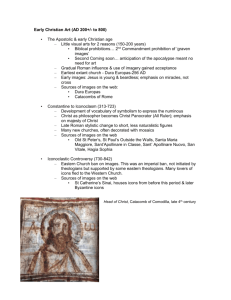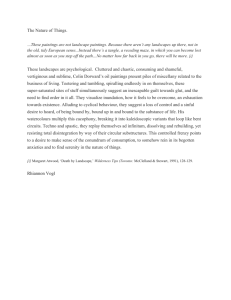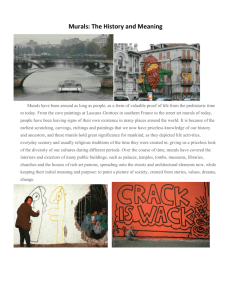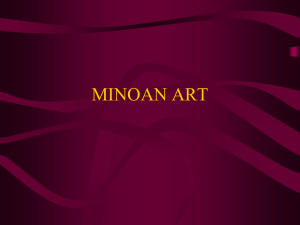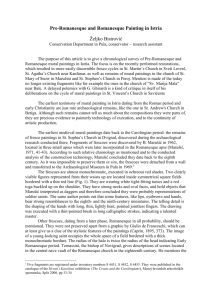Sixteenth-century Mural Painting in Istria
advertisement
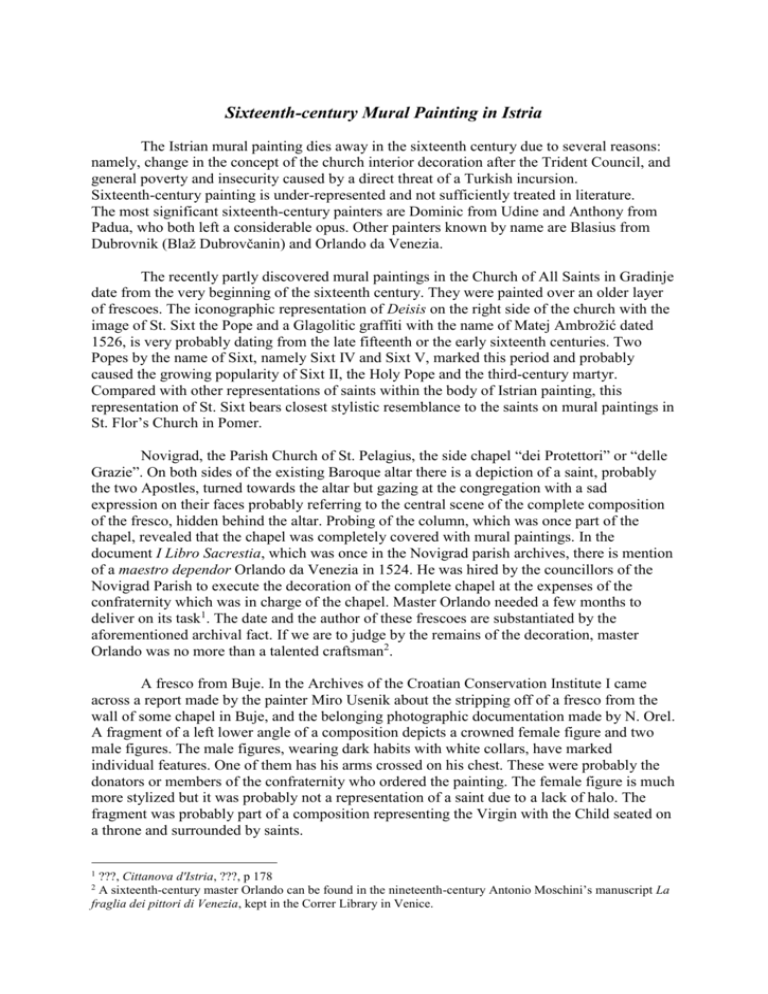
Sixteenth-century Mural Painting in Istria The Istrian mural painting dies away in the sixteenth century due to several reasons: namely, change in the concept of the church interior decoration after the Trident Council, and general poverty and insecurity caused by a direct threat of a Turkish incursion. Sixteenth-century painting is under-represented and not sufficiently treated in literature. The most significant sixteenth-century painters are Dominic from Udine and Anthony from Padua, who both left a considerable opus. Other painters known by name are Blasius from Dubrovnik (Blaž Dubrovčanin) and Orlando da Venezia. The recently partly discovered mural paintings in the Church of All Saints in Gradinje date from the very beginning of the sixteenth century. They were painted over an older layer of frescoes. The iconographic representation of Deisis on the right side of the church with the image of St. Sixt the Pope and a Glagolitic graffiti with the name of Matej Ambrožić dated 1526, is very probably dating from the late fifteenth or the early sixteenth centuries. Two Popes by the name of Sixt, namely Sixt IV and Sixt V, marked this period and probably caused the growing popularity of Sixt II, the Holy Pope and the third-century martyr. Compared with other representations of saints within the body of Istrian painting, this representation of St. Sixt bears closest stylistic resemblance to the saints on mural paintings in St. Flor’s Church in Pomer. Novigrad, the Parish Church of St. Pelagius, the side chapel “dei Protettori” or “delle Grazie”. On both sides of the existing Baroque altar there is a depiction of a saint, probably the two Apostles, turned towards the altar but gazing at the congregation with a sad expression on their faces probably referring to the central scene of the complete composition of the fresco, hidden behind the altar. Probing of the column, which was once part of the chapel, revealed that the chapel was completely covered with mural paintings. In the document I Libro Sacrestia, which was once in the Novigrad parish archives, there is mention of a maestro dependor Orlando da Venezia in 1524. He was hired by the councillors of the Novigrad Parish to execute the decoration of the complete chapel at the expenses of the confraternity which was in charge of the chapel. Master Orlando needed a few months to deliver on its task1. The date and the author of these frescoes are substantiated by the aforementioned archival fact. If we are to judge by the remains of the decoration, master Orlando was no more than a talented craftsman2. A fresco from Buje. In the Archives of the Croatian Conservation Institute I came across a report made by the painter Miro Usenik about the stripping off of a fresco from the wall of some chapel in Buje, and the belonging photographic documentation made by N. Orel. A fragment of a left lower angle of a composition depicts a crowned female figure and two male figures. The male figures, wearing dark habits with white collars, have marked individual features. One of them has his arms crossed on his chest. These were probably the donators or members of the confraternity who ordered the painting. The female figure is much more stylized but it was probably not a representation of a saint due to a lack of halo. The fragment was probably part of a composition representing the Virgin with the Child seated on a throne and surrounded by saints. 1 ???, Cittanova d'Istria, ???, p 178 A sixteenth-century master Orlando can be found in the nineteenth-century Antonio Moschini’s manuscript La fraglia dei pittori di Venezia, kept in the Correr Library in Venice. 2 The fresco from Buje has the same stylistic features as a cycle of recently discovered mural paintings from the chancel of St. Matthew’s Church in Slum. The stellar vault of the chancel is covered with images of Christ, the Prophets, the Apostles, the Evangelists and the Church Fathers, the Holy Trinity, and the scenes of the Annunciation, the Crucifixion, the Resurrection, Christ’s Descent into Limbo, and St. Georg Slaying the Dragon. The figures have rather stylized features, with stiff gestures and poses, especially in the narrative scenes. Christ, the Apostles and some of the Prophets are of somewhat better quality, especially Christ and St. Jerome, and there are some distinctive traits which they share with the aforementioned figures on the fresco from Buje. There are two sites in Istria in which we may find frescoes signed by Master Dominic: St. Roch’s Church in Sovinjak3 and St. Anthony’s Church in Višnjan. According to the different manner of execution of the two frescoes, Fučić has it that they were actually painted by two different painters.4 He attributed the frescoes in Sovinjak and some of the frescoes in St. Jacob’s Church in Bačva5 (Holy Sunday, Annunciation and image of Holy Father in the apse) to the more skilled painter of the two. And really there are many similarities in the style and iconography of the two murals. We have also observed the similarities between the less skilfully executed paintings in Bačva and those in St. Anthony’s Church in Višnjan. Bačva is only an hour’s walk away from Višnjan, so it strikes us there was a possibility of two Dominics from Udine on such a small area at the same time (mid-sixteenth century). The key to an understanding of mural paintings in St. Anthony’s Church in Višnjan lies in Bačva, in St. Jacob’s Church. The murals are executed by a workshop employing another painter next to Master Dominic. This painter is the author of almost all frescoes in St. Anthony’s Church. The biggest difference between the murals lies in the coloration, but it should not be taken into consideration because the Višnjan frescoes were significantly damaged due to humidity of the walls and an early twentieth-century restoration. They share the similar solution of their compositions and the same execution of anatomy and drapery as well as similar errors in the spatial disposition of the figures. The restoration in St. Jacob’s Church revealed ornamentation in the lower part of the wall, below the narrative scenes: marble-like rectangles in different colours, to be found in St. Anthony’s Church also, under a layer of retouch. The murals bear Dominic’s signature, but it was not he who painted the murals; as the head of the workshop, he contracted the business and was responsible for its execution, and he probably handed over the execution of the whole to a fellow-worker while he himself was free to work on another location. Bačva: originally, there were six scenes on the south wall: St. Georg Slaying the Dragon, Presentation at the Temple, Prayer on the Mount Olive, a damaged scene, Nailing of Christ, Crucifixion with Virgin Mary and St. John. The triumphal arch on the west wall is a background for the scene of the Annunciation, with seated figures of the Prophets under it. The image of Holy Father is painted in the apse, flanked by Sts. Peter and Paul to the right and an unknown saint to the left. The north wall depicted Christ facing Herod, Palm Sunday, Entombment, and Resurrection, while the two scenes nearest to the entrance are damaged. Dominic’s workshop executed murals on other locations as well, as, for example, the Church of the Holy Spirit near Štrped. There is the same bordure as in Bačva, the wide orange Branko Fučić, Freske u Sovinjaku, Buzetski zbornik ??? I was of the same opinion (see: Ž. Bistrović, Dominik iz Udina, Istarska enciklopedija, p ???), but the restoration works and research carried out on both sites tell different. 5 Branko Fučić, Majstor Dominik iz Udina, ??? 3 4 two-strand pattern. Dominic himself executed murals in the sacristy of the parish church in Fažana. This is especially interesting because in Višnjan Dominic signed as a Vodnjan dweller.6 The aforementioned bordure appears in Fažana as well. In St. Sebastian’s Church in Lindar there is a fresco partly revealed behind the wooden altar, which can be attributed to the same workshop. At the moment, only one arm holding a sword is visible, probably belonging to St. Paul. Blasius from Dubrovnik (Blaž Dubrovčanin), mural paintings in the Church of the Holy Spirit in Nova Vas near Šušnjevica.7 The north wall depicts the scene of the Adoration of the Magi signed by the master.8 There are images of St. Michael and St. Sebastian depicted on the same wall, as well as the scene of the Betrayal of Christ and Christ Standing Facing Pilate. The resurrected Christ among St. Peter and St. Paul is located at the eastern wall, with a pale-coloured Annunciation above it. The south wall depicts images of St. John the Baptist, St. Jacob and St. Roch; there is also a preserved scene of Virgin with Child surrounded by Music-making Angels and a fragment of a scene of which only one Music-making Angel is left. Prophets with scrolls and Evangelists in medallions encircled by laurel wreaths are located on the south and north walls. The rustic quality of this painting shows very close resemblance with the contemporaneous painting in the then Croatia9 and the areas in today’s Slovenia10. Despite obvious knowledge of the then painterly production and iconographic patterns, these paintings are of a much lower quality than the contemporary achievements in the nearby artistic centres of Italy and Austria. At the nearby locality in the Labin area, in the small church of St. Georg in Krajnica there were frescoes executed in a similar artistic manner.11 They represented images of Evangelists in medallions encircled by laurel wreaths, a detail which can also be found in the Church of the Holy Spirit in Nova Vas. There are also resemblances in the shaping, the drawing manner and the degree of stylization between the depictions of the Evangelists and those of the Prophets in Nova Vas. However rustic these murals might seem, there are even more rustic examples in Istria, like, for example, remains of frescoes from St. Peter’s Church at the cemetery in Marčenigla. A merely visible scene in the chapel depicts a procession coming from a church.12 The procession headed by a priest is heading left towards an indiscernible figure holding an open book. The figures in the procession hold a crucifix and a confraternity flag. The upper right angle of the scene depicts architecture which stands for the small churches of St. Helen and St. Peter. A lot of winding lines are probably representing fire which once might have threatened the village. This scene can be interpreted as an ex voto, that is, a remembrance of the event. It is a typical rustic, unrefined work, a product of a rural milieu, and is very difficult to determine it stylistically, let alone establish the date when it was painted. The areas of Buzet and Labin, that is, the eastern Istria and the Ćićarija region, were areas of the major painting activity in the sixteenth century. This was the time when many Although this could be the Dignano in Friuli instead of the one near Fažana. Kruno Prijatelj, Dva dalmatinska majstora u istarskim zbivanjima renesanse i manirizma, ??? 8 OPUS FECIT MAGISTER BLAXIO RAGUSEO (AN)NO DOMINI … 9 Zadobarje, Kalnik, etc. 10 The so called hrvaški malarji (Croatian painters) 11 Unfortunately, they do no longer exist. The church caved in and is now overgrown with thick underwood. The only information about the murals are old black-and-white photographs from the photo archives of the Conservation Department in Rijeka. 12 The small chapel has been subsequently painted. The inhabitants of Marčenigla know nothing of it. The only evidence of mural paintings is a photo from the photo archives of the Conservation Department in Rijeka. 6 7 churches in Ćićarija have been erected (Račja Vas, Brgudac probably, Nova Vas, Podgaće, Lanišće), probably as a result of massive colonization of new population in Istria and this region in particular. This could explain mural paintings in St. Mary’s Church in Kostanjica near Valtura, which was settled by people from Levant. The merely visible frescoes in the sacristy of St. Nicholas’ Church in Pula are probably dating from the late sixteenth or the early seventeenth centuries. We can not avoid noticing that the painters are mostly foreigners (Udine, Venice, Dubrovnik, etc.), the only Istrian painter that we know of being Anthony from Padua. This Padua could be the present village of Kašćerga. Fučić came to this conclusion according to Anthony’s signature and an analogy with a Glagolitic graffiti. His pictorial opus consists of mural paintings in the chapel of St. Roch’s Church in Draguć, St. Roch’s Church in Oprtalj and the Hum triptych kept in the Diocesan Museum in Poreč. The remains of the mural paintings in the Parish Church of the Holy Trinity in Račice could also be attributed to this master. The frescoes in the chapel of St. Roch’s Church in Draguć were probably painted on two occasions, in 1529 and 1537, as testified by a Latin and a Glagolitic inscription.13 The whole interior of the chapel is covered with frescoes. Although being the smallest Istrian chapel with frescoes, it is also the best preserved one. There are scenes from Christ’s life, depictions of saints, Prophets and the four Church Fathers, as well as peculiar iconographic scenes like the votive one depicting God ending massive dying caused by plague on St. Sebastian and St. Roch’s intervention. The two saints are depicted once more on the eastern wall, accompanied by St. Fabian. Above the entrance door there is an Imago Pietatis, with a Glagolitic inscription on the painting of the church written by the parish priest Andrija Prašić.14 There is yet another Glagolitic inscription written down by Andrija Prašić in which we learn that he was from Bužan in Lika region. This inscription is repeated on the Hum triptych, another one of Anthony’s works. The third, unsigned Anthony’s work are the frescoes in St. Roch’s Church in Oprtalj, partly preserved on the northern and the southern walls. The frescoes have not yet been restored and are still under a layer of plaster; yet, the great majority of figural representations are clearly visible, depicting only saints. The question of Anthony’s schooling and his artistic formation still remains unanswered. Although being an Istrian painter, he was probably trained in a workshop abroad. My guess is that was probably in Friuli, on a Late-Gothic tradition and some Renaissance iconographic patterns. In the Church of St. Peter the Apostle in Dignano al Tagliamento the chancel has been painted by Gianpietro da Spilimbergo. Here we can notice several traits which will help us to determine his artistic inspirations. Gianpietro makes ample use of red, a colour very often used by Anthony: he also made an ample use of it in the scene of the Temptation of Christ in the Desert, where it is used in the background, to define the architecture and the figures, as well as the bordures. Renaissance bordures derived from kantharoi and flower tendrils are a distinctive trait shared by both painters. The Church Fathers in St. Roch’s Church strongly resemble the figures in the medallions in St. Peter’s Church, the difference consisting in the fact that the representations of Church Fathers occupy a far more important place within the church interior, namely, on the vault itself. I shall make use of the image of St. John to explain the correspondences. He has long red hair, like many other Anthony’s figures, has a fragile effeminate physiognomy, and is round-faced and roundchinned like the page-boys in the scene of the Adoration of the Magi. And a technical and colouristic correspondence: St. John’s habit, as well as garments of some other figures depicted in this church, is orange, and green on the other, interior side. This reminds us of the habits worn by Christ and Satan in the scene of Temptation of Christ. But we have to keep in 13 But it is obvious that Anthony was not an expert in Roman figures, so it is possible that he wrote the date incorrectly. 14 B. Fučić, Meštar Anton s Padove, ??? mind we are talking about two different qualities of mural paintings. The correspondences between the two painters only indicate that the two are probably deriving from the same artistic milieu and bring forth Friuli as the possible place of their artistic formation. Istria and Friuli have a centuries-long history of mutual relations, thecolonization of the people from Friuli in Istria being only one of them. They came to Istria already in the nineteenth century in search of employments as artisans, construction-workers, painters. In history of art, especially in Istrian fresco painting, these connections were almost neglected until now. They are readily apparent in the sixteenth century, when the centuries-old tradition of fresco painting in churches ceased to exist. The sixteenth-century painting can be found on localities other than the mentioned ones. The frescoes kept in the Diocesan Museum in Poreč representing part of the scene of the Crucifixion, were originally standing in St. Roch’s Parish Church in Rakotule. In the church of St. Mary of the Carmelites the later, secco layer applied over Gothic frescoes is evidence of the remains of a fresco cycle depicting scenes from a saint’s life, but unfortunately, are not preserved enough to tell us more about the whole composition. There are hardly visible remains of a scene with two female saints in St. Lucia’s Church in the homonymous hamlet at the foot of Oprtalj. They are both turned right, one of them holding a palm branch, the other wearing a crown. The colour of the complexion has tarnished and the scene is merely visible also due to an unprofessional removal of subsequent layer of paint. Along with so many sacral sites, mention should be made of the only preserved testimony of fresco decoration applied to a secular, i.e. communal building in this period: the fresco paintings in the Town Hall in Rovinj.

